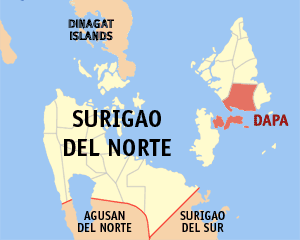
Surigao del Norte is a province in the Philippines located in the Caraga region of Mindanao. The province was formerly under the jurisdiction of Region 10 until 1995. Its capital is Surigao City. The province comprises two major islands—Siargao and Bucas Grande—in the Philippine Sea, plus a small area at the northeastern tip of mainland Mindanao and other surrounding minor islands and islets. This mainland portion borders Agusan del Norte – between the Municipality of Alegria in Surigao del Norte and the Municipality of Kitcharao in Agusan del Norte; and the province of Surigao del Sur, to the south.

Dapa, officially the Municipality of Dapa, is a 4th class municipality in the province of Surigao del Norte, Philippines. According to the 2020 census, it has a population of 29,006 people.

Del Carmen, officially the Municipality of Del Carmen, is a 5th class municipality in the province of Surigao del Norte, Philippines. According to the 2015 census, it has a population of 18,392 people. The municipality was formerly called Numancia until 1966 when it was changed to its present name. It is located on Siargao Island and home to Sayak Airport, the island's main airport.

General Luna, officially the Municipality of General Luna, is a 5th class municipality in the province of Surigao del Norte, Philippines. According to the 2020 census, it has a population of 22,853 people.

Pilar, officially the Municipality of Pilar, is a 5th class municipality in the province of Surigao del Norte, Philippines. According to the 2020 census, it has a population of 10,374 people.

Surigao City, officially known as the City of Surigao, is a 3rd class component city and capital of the province of Surigao del Norte, Philippines. According to the 2020 census, it has a population of 171,107 people.

Siargao is a tear-drop shaped island in the Philippine Sea situated 196 kilometers southeast of Tacloban. It has a land area of approximately 437 square kilometres (169 sq mi). The east coast is relatively straight with one deep inlet, Port Pilar. The coastline is marked by a succession of reefs, small points and white, sandy beaches. The neighboring islands and islets have similar landforms.
The legislative districts of Surigao del Norte are the representations of the province of Surigao del Norte in the various national legislatures of the Philippines. The province is currently represented in the lower house of the Congress of the Philippines through its first and second congressional districts. The 1st legislative district comprises nine municipalities on the islands of Siargao and Bucas Grande ; the 2nd legislative district comprises Surigao City and eleven other municipalities on the mainland of Mindanao.
Dapa Poblacion is the port area and poblacion of the municipality of Dapa, Surigao del Norte, in the Philippines. It is located in the southwest area of Siargao Island.

Rodrigo Duterte's tenure as the 16th president of the Philippines began with his inauguration on June 30, 2016, following his landslide victory in the 2016 presidential election, succeeding Benigno Aquino III. Duterte's election victory was propelled by growing public frustration over the tumultuous post-EDSA democratic governance, which favored political and economic elite over ordinary Filipinos. His presidency spanned six years, ending on June 30, 2022. Duterte is the first president from Mindanao; the oldest person to be elected president of the Philippines, at age 71; and the first Philippine president to have worked in the three branches of the government.

The New Clark City Sports Hub or the New Clark City Sports Complex is a complex of sports facilities located inside the National Government Administrative Center of New Clark City in Capas, Tarlac.

Mactan–Cebu International Airport is the second busiest international airport in the Philippines. It is located in the city of Lapu-Lapu on Mactan, a part of Metro Cebu and serves the Central Visayas region. The airport is managed by the Mactan–Cebu International Airport Authority and serves as a hub for Cebu Pacific, Pan Pacific Airlines, and Royal Air Philippines.
The Philippine Sports Training Center (PSTC) is a sports complex proposed to be built in Bagac, Bataan, Philippines. It will be owned by the Philippine Sports Commission and will be the official training facility for members of the Philippine national teams and national training pool.
2021 in the Philippines details events of note that have occurred in the Philippines in 2021. The COVID-19 pandemic, which largely defined 2020, continued into 2021.

Typhoon Louise–Marge, known in the Philippines as Typhoon Ining–Liling, was a powerful tropical cyclone that impacted Palau and the Philippines in November 1964. It was one of the most destructive typhoons documented in the central Philippines. Tracking data from meteorological agencies disagree whether the storm was a single tropical cyclone or two distinct tropical cyclones that occurred in quick succession, named separately by the Joint Typhoon Warning Center (JTWC) as Louise and Marge. Louise–Marge's peak intensity and first landfall on the Philippines were associated with the Louise portion of the storm's history, while the Marge portion was weaker and shorter lived.

Surigao del Norte's 1st congressional district is one of the two congressional districts of the Philippines in the province of Surigao del Norte. It has been represented in the House of Representatives since 1987. The district encompasses the island chains off the northeast coast of mainland Surigao del Norte. Since the 2007 redistricting following the separation of Dinagat Islands, the district now comprises the Siargao and Bucas Grande municipalities of Burgos, Dapa, Del Carmen, General Luna, Pilar, San Benito, San Isidro, Santa Monica and Socorro. It is currently represented in the 18th Congress by Francisco Jose Matugas II of the PDP–Laban.

Typhoon Rai, known in the Philippines as Super Typhoon Odette, was a powerful and catastrophic tropical cyclone that struck the Philippines in December 2021. Rai became the first Category 5-equivalent super typhoon to develop in the month of December since Nock-ten in 2016, and the third Category 5 super typhoon recorded in the South China Sea, following Pamela in 1954 and Rammasun in 2014. The 22nd tropical storm, the ninth typhoon, and the fifth super typhoon of the 2021 Pacific typhoon season, the system originated from a tropical disturbance near the equator on December 10, forming near the site of another low-pressure area that had dissipated on the previous day. Conditions around the system were favorable for further development, and it slowly developed into a tropical depression on December 12. On the same day, the United States Joint Typhoon Warning Center (JTWC) issued a Tropical Cyclone Formation Alert (TCFA) on the consolidating depression. Further intensification ensued, and Rai was upgraded to a tropical storm the next day, before passing south of Ngulu Atoll. After passing near Palau and impacting the island nation, Rai entered the Philippine Area of Responsibility (PAR) by the night of December 14, where the Philippine Atmospheric, Geophysical and Astronomical Services Administration (PAGASA) named it "Odette". On the next day, both the JMA and JTWC raised the system's intensity to a low-end Category 1-equivalent typhoon, as an eye continued to appear. While approaching the Philippines, Rai unexpectedly rapidly intensified into a Category 5 super typhoon for a typhoon with winds of at least 240 km/h (150 mph).</ref> just before its first landfall across Siargao. It then slowly but steadily weakened as it traversed the Visayas, exiting into the Sulu Sea. After making its last landfall over Palawan, Rai continued to weaken before unexpectedly re-intensifying into a Category 5-equivalent typhoon by December 18, while nearing Vietnam. On the next day, Rai entered yet another weakening phase, dissipating on December 22, southeast of Hong Kong.













